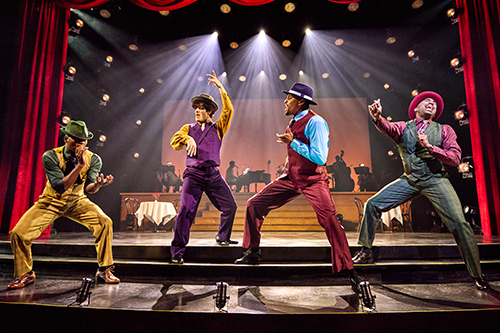After Midnight
Paper Mill Playhouse, Millburn, NJ, February 4, 2024
Reviewed by Chip Deffaa

When After Midnight ran on Broadway during the 2013-2014 season (after being developed by City Center Encores and Jazz at Lincoln Center), it boasted a company of 25 singers/dancers and a 16-piece big band. Paper Mill Playhouse is currently presenting (through February 25) a show called After Midnight, but it is considerably smaller in size, impact, and artistic achievement than the original Broadway production.
A note in the program from Paper Mill’s producing artistic director Mark S. Hoebee and executive director Mike Stotts said: “Paper Mill is now the first major theater in the country to revive the title in a new, intimate format.” They call the production “a sumptuous salute to Black Culture from 1920s New York City” and a “big-band song-and-dance showcase.”
Well, in six decades of theater going, I have never seen a good Broadway show be so profoundly damaged by the process of downsizing. The Broadway production (and its City Center Encores/Jazz at Lincoln Center predecessor) was indeed a “big-band song-and-dance showcase.” But at Paper Mill there is no longer even a big band. On Broadway, the conductor directed 16 musicians; that was indeed a big band and they faithfully played Duke Ellington classics from the 1920s and ’30s, meticulously transcribed by such experts as Mark Lopeman and David Berger.

At Paper Mill, only seven musicians are given the impossible task of trying to re-create Ellington numbers written for significantly larger ensembles. I hated hearing one superb Ellington arrangement after another butchered. How can you call your presentation a “a sumptuous salute to Black Culture from 1920s New York City” when you demonstrate such little respect for or appreciation of Ellington’s music? Ellington would have been appalled to hear his masterfully written big-band charts—crowning cultural glories of the era—gutted like this, and Ellington’s music is the heart of this show.
But this band had only one trumpet, one trombone, one sax, and four rhythm players. A number such as “Braggin’ in Brass” (originally recorded by Ellington in 1938 with a four-man trumpet section and a three-man trombone section) doesn’t work with only one trumpet and one trombone. It’s not “Braggin’ in Brass” anymore; it’s more like “Muttering in Brass.” A thinned-out version of “Take the ‘A’ Train” (one of the best-known works of the big-band era, used for exit music here) was, for my ears, painful to hear; it had no guts and it was more like lounge music.

Photo: Jeremy Daniel
The wonderfully shaded Ellington classics like “The Mooche,” “East St. Louis Toodle-Oo,” and “Black and Tan Fantasy,” as perfectly written as any charts written in that period, made Ellington’s band unique. For very good reasons it was the favorite big band of so many jazz musicians. Ellington was in a class by himself. As my late friend, the writer and music expert James T. Maher put it, “Ellington skinned our ears” with his new music. But the cut-down charts being played at Paper Mill won’t skin anyone’s ears. Ellington was all about tonal colors and making unexpected tonal blends. All of his extraordinary genius, which stunned me just as much when I saw Ellington and his orchestra “live” in 1973 as when I savored their many recordings, was lost when the arrangements are so drastically reduced. The subtleties and nuances vanish, and the music became less interesting. The 2013 Broadway production (which Wynton Marsalis helped to produce) got the music right, and that provided a solid foundation for all of the singing and dancing. The authentic music gave the show (which was originally conceived by Jack Viertel and directed and choreographed by Warren Carlyle) its character.
Paper Mill’s production featured just 10 singers/dancers (down from the 25 in the Broadway show). While I would have preferred seeing a larger cast of singers/dancers, here downsizing of the cast was not nearly as problematic as the downsizing of the band. Ellington’s music was emasculated by being played by a septet rather than a big band. That’s no reflection on the individual musicians (under the direction of Sean Mayes) who got tempos and moods just right and evoked the famed original instrumental solos with accuracy. But so much of Ellington’s magic is lost when so small a group has to struggle to evoke the sound of the original big-band arrangements
I found all 10 of the singers/dancers likeable; they evoked the period well. My two favorites among them, Awa Sal Secka and Sasha Hutchings, connected wonderfully with the audience. Secka’s interpretation of the timeless “Go Back Where You Stayed Last Night” was a particular treat. Oh! She was just great, and I look forward to seeing her in other shows. I thought Stanley Martin were endearing throughout. Every singer/dancer got his or her moment. Because so many numbers are sung simply as solos or duets, the reduction of the cast size from 25 to 10 wasn’t as bothersome as the reduction of the orchestra’s size. (Granted, 10 dancers can’t quite create the same kind of excitement in the big ensemble numbers that 25 dancers can.) The costumes by Azalea Farley were terrific.
The choreography by Dominque Kelly—wonderfully sly and stylized—was a succession of delights. Co-directors Dominique Kelley and Jen Bender kept things moving well, often cleverly. One flaw, though, needs to be corrected. An audience tells a director what works. The scene that sets up the funeral numbers, “The Gal from Joe’s” and “Black and Tan Fantasy,” should be reworked. At the performance I attended (opening night) the scene got laughs; if audience members laugh when you’re setting up a serious moment, you have to make changes.
This is a revue (not a book musical). It presents more than two dozen songs without a storyline. The show ran for about 90 minutes, as did the Broadway version, but it seemed longer. Lacking variety in terms of instrumental color and on the way the musical numbers were staged, it seemed before the show ended that we’ve seen what everyone can do, and it became repetitious.
I understand the desire to cut costs by cutting down the size of the band and the size of the cast. I still wish that the cuts hadn’t been so extreme. If you can’t afford 16 musicians, you can still evoke the essence of Ellington’s music pretty nicely with 14 musicians or even 12. But seven just doesn’t work. Once you cut the band down below 11 musicians—the absolute minimum—you’ve ruined the character of Ellington’s music.
This music is as good as any music from the era., and it deserved to be performed right. In their program note, the co-directors said they were trying to take us inside the Cotton Club, to give us a sense of what a night at the Cotton Club was like. To do that, though, you have to get the music right.





